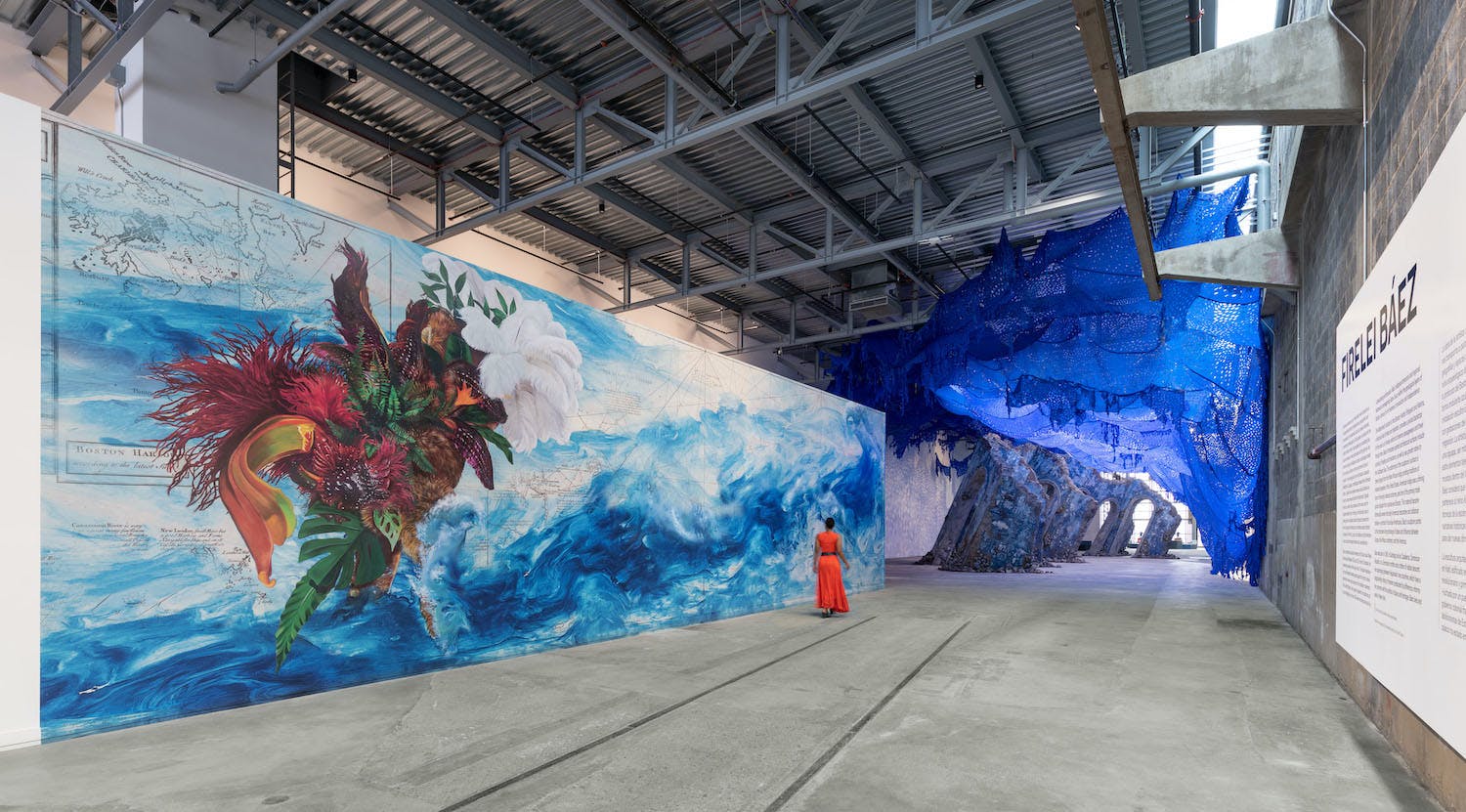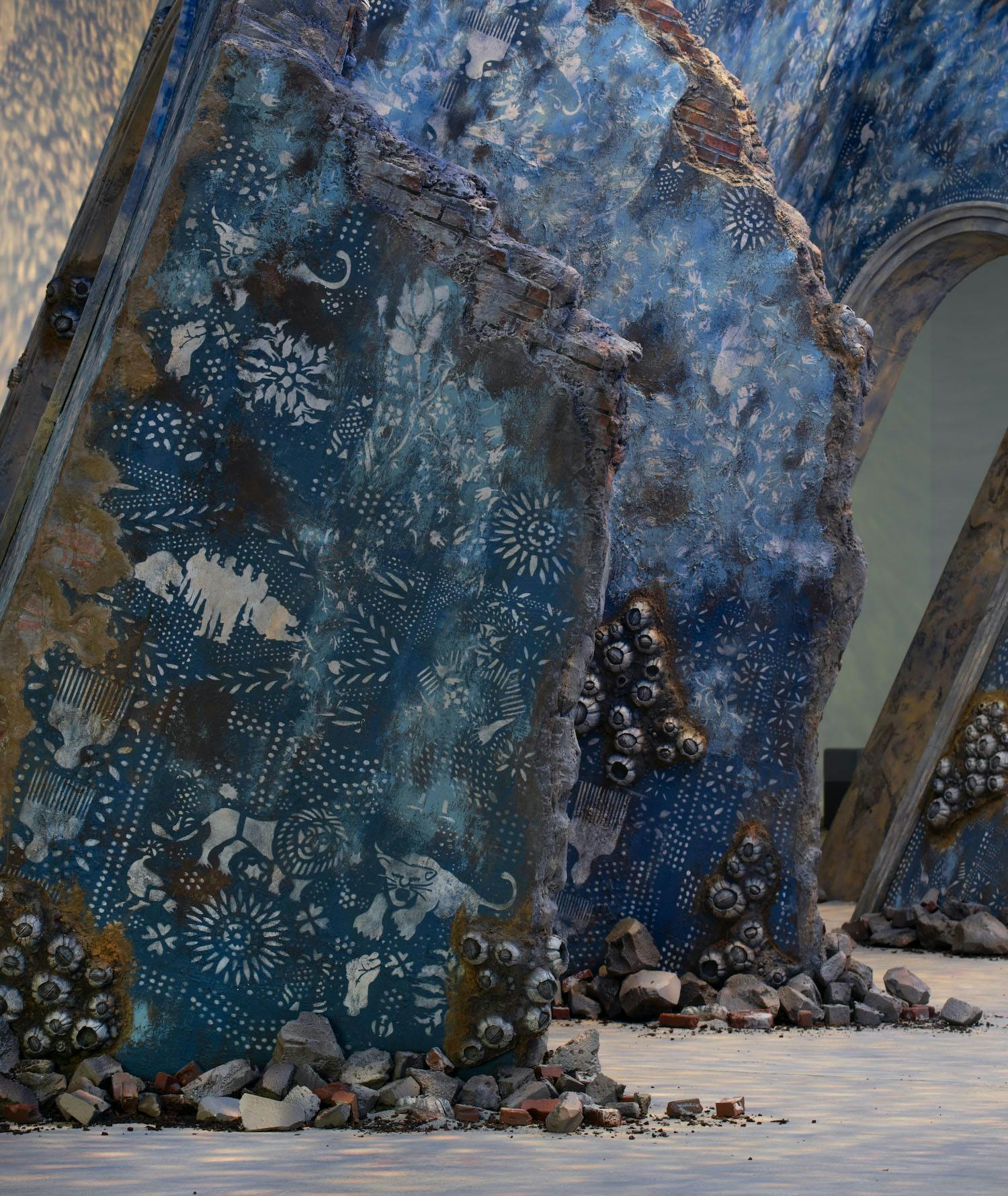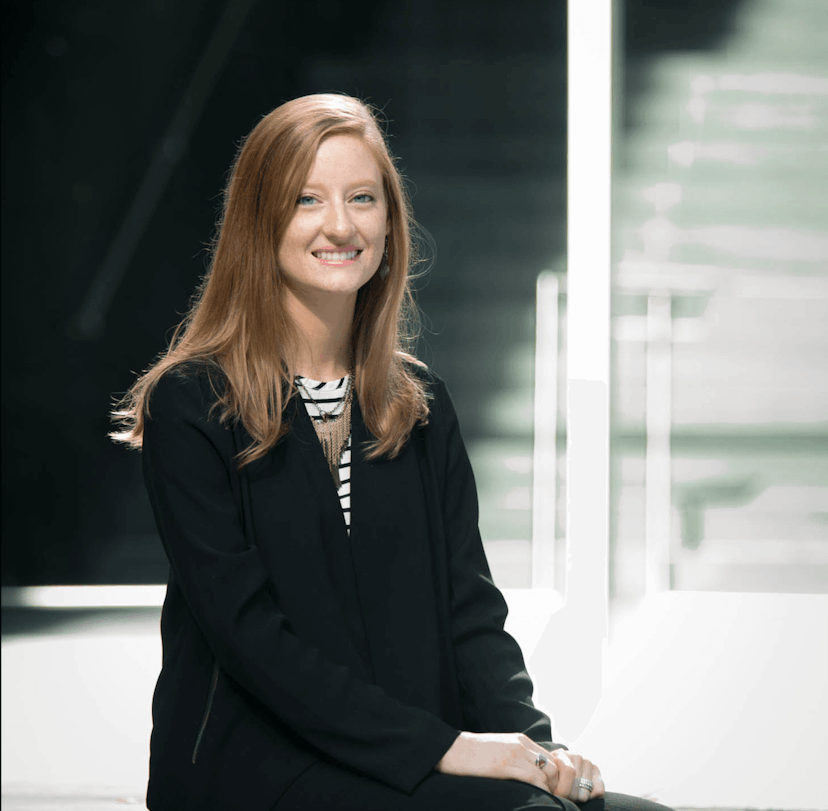Since 2018, the Institute of Contemporary Art has invited an artist to produce a site-specific work during the summer season in its Watershed gallery space in East Boston. Dominican American artist Firelei Báez was preparing a project for the summer of 2020 when the pandemic hit. The installation was postponed by a year, but if anything, the delay allowed the roots of Báez’s commentary on transnational revolutionary histories and Afro-Caribbean diasporic narratives to grow deeper.
On entering the space, visitors encounter an enormous mural running fifty feet along a wide hallway that leads into the building. Báez produced this piece by taking an enlarged historical map of the New England coast and overlaying it with swirling sea currents whose roiling blue expanses threaten to obliterate the neatly delineated cartographic composition of the original document. Here and there, snippets of text peek through the waves, revealing instructions for how best to navigate treacherous American shorelines.
To the left of the unfolding scene, one of Báez’s signature Ciguapa figures floats resplendently above the seascape, her jewel-toned petals, verdant fronds, and soft feathers contrasting with the parchment and currents beneath her. Ciguapas are described in Dominican folklore as beautiful and terrifying female entities, and Báez reworks them into symbols of diasporic strength. In the mural the Ciguapa disrupts neat narratives of colonial voyages literally—churning the waters—and figuratively, recalling Afro-Caribbean diasporas often subsumed in the archives where maps like this one might reside.
Proceeding deeper into the cavernous, 15,000-square-foot Watershed facility, viewers are confronted by a massive stone structure that simultaneously registers as an archaeological ruin submerged in Boston Harbor and a stage set designed to look like such a scene. The stone is actually made of plaster, wood, and metal, and the overtly constructed quality of the installation reminds viewers that history itself is a construction—what and who we remember, how we remember them, and the ways we link (or choose not to link) peoples, places, and events over time are deeply subjective narrative decisions.
Báez is invested in resuscitating overlooked historical and geographic linkages. The soaring yet listing columns and archways in her installation reveal the splendor of a bygone place and time, pulled into the here and now of Boston today. The histories she conjures become a dazzling display of transnational revolutionary roots, as Báez, who is of Haitian as well as Dominican descent, explains that the ruins are inspired by Haiti’s Sans-Souci Palace.
Sans-Souci was built in the early nineteenth century for Henri Christophe, a man of West African descent who was enslaved by British and French Caribbean plantation owners before he became a leader in the Haitian Revolution and subsequently the first king of Haiti. The castle was heavily damaged in an 1842 earthquake and has since sat in ruin, but it remains a monument to revolutionary histories. During the Haitian Revolution, Christophe and other self-liberated enslaved people threw off the rule of the French colonial government, eventually gaining independence and founding the first Black republic in 1804.
By locating the Haitian ruin along Boston Harbor, Báez links the revolutionary and abolitionist heritage of Haiti to that of Boston, a city celebrated for its role in the American Revolution and the national antislavery movement. Accounts indicate that Christophe himself may have served in a French regiment during the American Revolution, and the later liberation of enslaved people in Haiti served as a significant precedent for American abolitionists. If the map on the mural charts geographic distances, then the constructed palace remains collapse those distances. Báez has titled the project To breathe full and free: a declaration, a re-visioning, a correction (19°36’16.9″N 72°13’07.0″W, 42° 21’48.762″ N 71°1’59.628″ W), the coordinates referencing both the site of Sans-Souci and the Watershed, locating them side by side. Báez’s project is rooted in a liminal space that refuses the binaries of here and there, us and them, history and imagination, past and present.
The temporal collapse is heightened by an audio component; as visitors wind their way through the ruins, their movement sets off disembodied voices that emanate from each archway, describing contemporary experiences of migration. The speakers relay their stories in English, Spanish, Haitian-Creole, and Mandarin, a linguistic layering that nods to the widespread experience of diaspora globally as well as the diversity of East Boston specifically. The cacophony of voices is at times drowned out by sounds of the sea, bustling ports, and calling gulls—some coming from the audio recordings, others floating in from Boston Harbor. Catching every word does not seem to be the point; rather, the fragmented soundscape poetically connects contemporary stories with those of the past. The Boston Harbor location additionally evokes histories of slave traders, immigrants, and detention centers.
Báez uses medium and color to further collapse boundaries. A blue tarp hangs from the ceiling and sails down the walls, cutouts meticulously made by the artist and her team creating a glittering effect. The beauty of the draping tarp is tempered by this material’s evocation of destructive hurricanes made stronger and more frequent by climate change; tarps protecting damaged buildings are a common sight on Caribbean islands and elsewhere in the Global South in the aftermath of extreme weather.
The characteristic blue color of the tarp is echoed in symbols representing healing and resistance that appear on the walls of the ruin in stenciled blue patterning next to Caribbean sea growths that hint at rising seas. Báez drew inspiration for the patterns from West African indigo textile printing traditions transported to the United States by enslaved people. Indigo became a significant trade item in colonial America, and in fact it was one of the primary goods shipped from Boston during this era. In another nexus point, pre-revolutionary Haiti traded indigo produced by slave labor. Today, indigo may connote blue jean Americana, but Báez directs viewers to take a longer, more complex view of the product.
Báez is a trained painter, but in recent years she has forayed into the production of sculptural installations, of which the Watershed project is her largest to date. She views these works as an extension of her painting practice that allows for a more immersive viewer experience. The artist emphasizes a desire for visitors to move around the Watershed gallery, weaving among the pillars of the installation, feeling the breeze coming off the harbor, hearing the installation audio and neighborhood sounds, smelling the sea, and perhaps thinking about their own cultural roots and how they relate to past histories and the present world. The interpretive potential is capacious and reflective of the artist’s own creative and deeply personal approach to history and experience. Báez refuses to set limitations on her work based on archives written by and for others, instead making imaginative leaps that lyrically fill in the gaps of her diasporic Afro-Caribbean heritage. The stories she facilitates reveal more nuance and perhaps ultimately greater truths than canonical accounts that have long privileged Euro-American narratives, discounted diasporic histories, and obscured transcultural roots that connect them.
To breathe full and free: a declaration, a re-visioning, a correction (19°36’16.9″N 72°13’07.0″W, 42° 21’48.762″ N 71°1’59.628″ W), organized by Eva Respini, is on view at the ICA Watershed July 3 through September 6, 2021.



